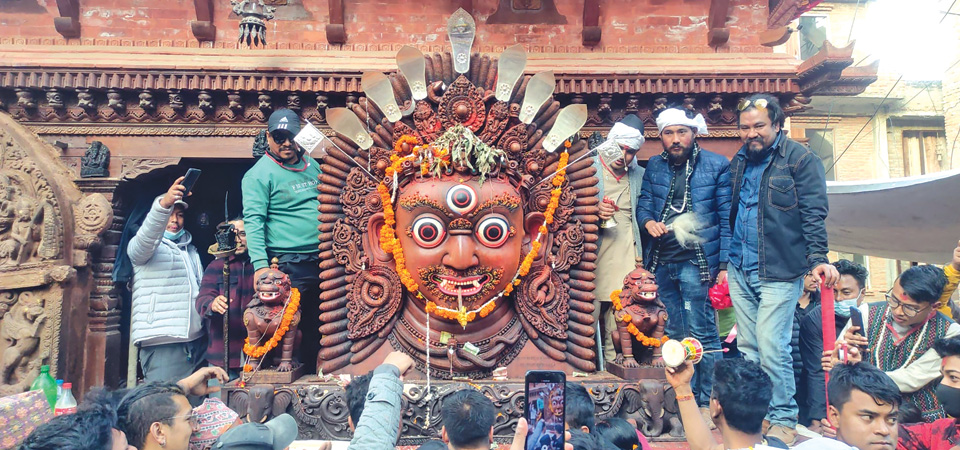Kirtipur's Hathu Hyakegu ritual revives after generations

Kirtipur, Mar. 5: Chhyang (rice beer) flowed from the mouth of Bhairav – for the first time in generations – in Kirtipur on Tuesday.
The tradition, often solely associated with Basantapur and Indra Jatra, was performed for the first time in decades in the ancient city of Kirtipur on the occasion of Shivaratri. Called Hathu Hyakegu, it was performed following the consecration of what is possibly the largest wooden mask of Bhairav at the Phalcha (rest house) at Chithu, Kirtipur Municipality–10.
The five-foot tall mask was made in Bungamati with wood brought from Hetauda by artists Ram Bhakta Maharjan, Amir Shakya and Jitendra Tuladhar. According to Bharat Maharjan, a Newa culture scholar and a local of Chithu, famous sculptor Laxman Maharjan was supposed to carve the face but he passed away after contracting COVID-19. “So, his students took up the responsibility and completed the mask in their teacher’s name,” he said.
Similarly, the seat (Twaka) of the Bhairav was made by craftsman Sher Bahadur Maharjan of Balambu. Artisan Ram Prakash Shrestha provided the finishing touches to the final bust.
The Bhairav mask was brought from Bungamati to Kirtipur amid a grand musical procession and was inaugurated Tuesday evening by veteran comedian Madan Krishna Shrestha in the presence of the mayor, deputy mayor and other officials of Kirtipur Municipality.
“The establishment of Lord Bhairav at the Phalcha was a momentous occasion in itself but what made it truly historic was the revival of Hathu Hyakegu in Kirtipur,” Maharjan said.
Yes, revival; because while Tuesday was the first time in a long time that Hathu Hyakegu was performed in the city, it was not the first time in history. Once upon a time, the custom was an integral part of Kirtipur’s culture and was celebrated in a grand manner as in Hanumandhoka, Maharjan, who is also the coordinator of the local Hathu Tradition Revival Campaign, informed.
As proof, he points to the inscriptions located in various parts of Kirtipur that mention the practice. One, dated Nepal Samvat (NS) 813 (1693 AD), located in Singhaduwa talks about Gyan Singh Bharo and Dharam Singh who donated seven Ropanis of land in Panga to perform Hathu on the fourth lunar day of the dark fortnight of Chaitra. Similarly, another stele from NS 814 (1694 AD) standing in Kwa Chwo contains instructions from a local leader who provided 14 Ropanis of land and instructed the residents to use 40 Pathis of rice obtained from the land to conduct Hathu Hyakegu every year on the day of Samay Baji Purnima (Indra Jatra).
Yet another inscription from NS 818 (1698 AD) reveals that Hathu Hyakegu used to be performed in I-chhén and historian Dhanavajra Vajracharya in his book ‘Madhyakālakā abhilekha’ translates a copper sheet present in the Baghbhairav Temple that credits one Dundiraj Bharo with establishing a golden Bhairav in the Gundey Chapa: community hall and starting the tradition of pouring Chhyang from its mouth on the day of Simha Sankranti.
“But none of the individuals or families associated with these lands and customs know of Hathu Hyakegu,” Maharjan said. “This shows just how long ago the tradition died in Kirtipur.”
Work on reviving this long-lost tradition began in 2019 at the initiative of the local Sun Star Club.
“The masque took more than two years and cost over Rs. 3 million to make. And this amount was completely raised from the local people,” Maharjan said. Various organisations as well as government bodies would have supported the initiative but the Hathu Revival Campaign consciously chose to only involve the locals “so as to breed a sense of ownership.”
And it is this ownership that Maharjan hopes will help sustain this revived tradition. “We plan to perform Hathu Hyakegu every year on Indra Jatra but we do not have enough financial resources for it.
“The Bhairav mask features intricacies that no modern bust does. It was worshipped following tantric rituals that had not been performed in Kirtipur for decades, if not centuries. To participate in the procession, musicians who had not picked up an instrument in ages not only re-learnt to play but also passed their knowledge on to younger generations. At a time when traditional groups and trusts are vanishing, a new 20-member Guthi has been established for the deity.
“One single custom gave us a glimpse into what Kathmandu’s society was like in its heyday and what it can be if it is continued,” Maharjan added, urging all to help preserve the ritual to preserve a part of Kathmandu Valley’s civilisation.
In Hathu Hyakegu, people drink Chhyang poured from the mouth of Bhairav, believing it to offer protection from diseases, ailments and enemies. While mainly relate it to Swet Bhairav of Hanumandhoka, the tradition exists or was in existence in various parts of Khokana, Tokha, Lubhu, Bhaktapur, Thimi, Patan, Harisidhhi and Kirtipur too.
Recent News

Do not make expressions casting dout on election: EC
14 Apr, 2022
CM Bhatta says may New Year 2079 BS inspire positive thinking
14 Apr, 2022
Three new cases, 44 recoveries in 24 hours
14 Apr, 2022
689 climbers of 84 teams so far acquire permits for climbing various peaks this spring season
14 Apr, 2022
How the rising cost of living crisis is impacting Nepal
14 Apr, 2022
US military confirms an interstellar meteor collided with Earth
14 Apr, 2022
Valneva Covid vaccine approved for use in UK
14 Apr, 2022
Chair Prachanda highlights need of unity among Maoist, Communist forces
14 Apr, 2022
Ranbir Kapoor and Alia Bhatt: Bollywood toasts star couple on wedding
14 Apr, 2022
President Bhandari confers decorations (Photo Feature)
14 Apr, 2022









